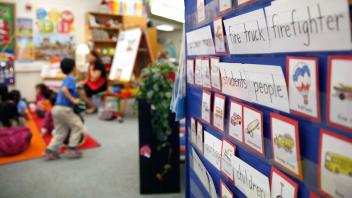Learning to spell is built on a child’s understanding that words are made up of separate speech sounds (phonemes) and that letters represent those sounds. As they get more experience with words, children begin to notice patterns in the way letters are used and recurring sequences of letters that form syllables, word endings, word roots, prefixes, and suffixes.
In the primary grades, spelling instruction overlaps with phonemic awareness and phonics instruction, and many of the practices that used in teaching phonics also support teaching early spelling. Spelling is important because it helps children cement their understanding of printed words.
Encoding or writing words, relies on the same underlying skills as decoding, or reading print. Children generally learn to read a word before they can spell it. With lots of exposures and practice, children will have accurate representations of printed words in memory. Spelling instruction helps children map and store words permanently for accurate and quick writing.
Putting spelling in perspective
Most English words can be spelled if you know the basic patterns, principles, and rules of spelling. Students can use these rules as an aid to spelling unknown words. If a child can spell a word, he or she can usually read the word.
There are about 400,000 words in the English dictionary. In about 50% of the words, sound and letter associations map simply and perfectly. These words don’t have to be memorized. About 40% are easily learned through instruction of slightly more complex letter–sound correspondences. Only about 10% of English language words are truly exceptional, in that they must be memorized by sight.
Dr. Louisa Moats: Spelling
Dr. Louisa Moats, an expert in the area of improving literacy and elementary education, talks about the importance of spelling in understanding word structure and speech sounds.
What spelling instruction should include
- Alphabetic principle: Knowledge of which individual letters match up to sounds, in a left to right sequence (In the word cup, each sound is represented by a single letter).
- Pattern information: Which groups of letters function as a pattern to represent sounds. Examples of patterns would include: CVC (Consonant/Vowel/Consonant) pattern to form short vowels (e.g. like the word cat) or CVCe/CVVC patterns to form long vowels (e.g., like the words same or meat).
- Spelling variations based on word origins (e.g., ‘ch’ sounds like /ch/ in Anglo-Saxon words like check, /sh/ in French words like niche, and /k/ in Greek words like chaos).
- Meaning (morphological or morphemic) information: Which groups of letters represent meaning (The prefix re- as in redo, means to do again). Instruction should include teaching common prefixes, bases/roots, and suffixes. Advanced readers can deepen their vocabularies by learning Greek combining forms and Latin roots.
How to teach word study and deep spelling (part 1)
Donald Bear (co-author of Words Their Way) discusses how to use word study and deep spelling instruction in a comprehensive literacy program.
How to teach word study and deep spelling (part 2)
More on spelling
Launching Young Readers
Writing and Spelling
Reading 101 Learning Modules
Spelling: Introduction
Early Literacy Development
How Spelling Supports Reading
Spelling and Word Study
Choose Your Words (and Techniques) Carefully in Spelling Instruction
Classroom Strategy
Word Walls
Guides and Toolkits
Why Teach Spelling?
Featured video
Browse our spelling and word study resource library
Learn more about teaching spelling through our articles, tips for parents, video, FAQs, and research briefs. Visit our Spelling and Word Study section






